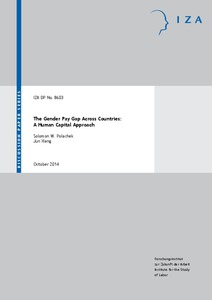The gender pay gap across countries: a human capital approach

Polachek, Solomon W. ; Xiang, Jun
Institute of Labor Economics, Bonn
IZA - Bonn
2014
31 p.
gender ; human capital ; wage differential ; labour market policy
Discussion Paper
8603
Wages and wage payment systems
English
Bibliogr.
"The gender wage gap varies across countries. For example, among OECD nations women in Australia, Belgium, Italy and Sweden earn 80% as much as males, whereas in Austria, Canada and Japan women earn about 60%. Current studies examining cross-country differences focus on the impact of labor market institutions such as minimum wage laws and nationwide collective bargaining. However, these studies neglect labor market institutions that affect women's lifetime work behavior – a factor crucially important in gender wage gap studies that employ individual data. This paper explicitly concentrates on labor market institutions that are related to female lifetime work that affect the gender wage gap across countries. Using ISSP (International Social Survey Programme), LIS (Luxembourg Income Study) and OECD wage data for 35 countries covering 1970-2002, we show that the gender pay gap is positively associated with the fertility rate, positively associated with the husband-wife age gap at first marriage, and positively related to the top marginal tax rate, all factors which negatively affect women's lifetime labor force participation. In addition, we show that collective bargaining, as found in previous studies, is negatively associated with the gender pay gap."
Digital
The ETUI is co-funded by the European Union. Views and opinions expressed are however those of the author(s) only and do not necessarily reflect those of the European Union or the ETUI.